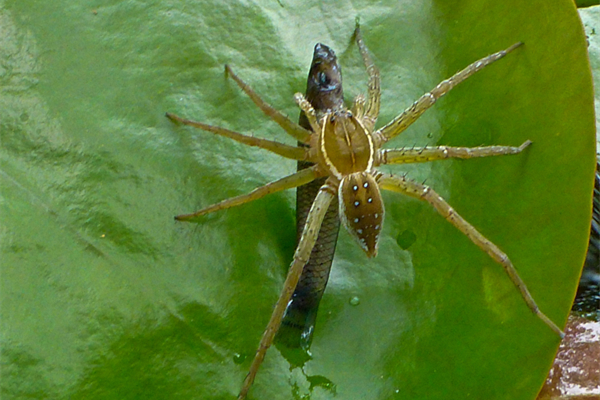Fish-eating spiders discovered worldwide
 0 Comment(s)
0 Comment(s) Print
Print E-mail Xinhua, June 19, 2014
E-mail Xinhua, June 19, 2014
Spiders from at least eight different families can prey on small fish and "fishing spiders" are probably geographically widespread, occurring on all continents except Antarctica, according to a study published Wednesday in the U.S. open-access journal PLOS ONE.
 |
|
Spiders from at least eight different families can prey on small fish and "fishing spiders" are probably geographically widespread. |
Spiders are traditionally viewed as predators of insects, but in recent years, researchers have become increasingly aware that spiders are not exclusively insectivorous, and that certain larger- sized species might supplement their insect diet by occasionally catching small vertebrate prey.
In the new study, Martin Nyffeler of the University of Basel, Switzerland and Bradley Pusey of the University of Western Australia gathered and documented numerous incidents of spiders predating fish from all around the world.
According to their systematic review, spiders from as many as five families have been observed predating on small fish in the wild and three more families contain species that catch fish under laboratory conditions.
These so called semi-aquatic spiders typically dwell at the fringes of shallow freshwater streams, ponds or swamps, the researchers said.
These spiders, some of which are capable of swimming, diving and walking on the water surface, have powerful neurotoxins and enzymes that enable them to kill and digest fish that often exceed them in size and weight, they said.
The study showed that naturally occurring fish predation by spiders has been reported from all continents with the exception of Antarctica.
Most incidents have been documented in North America, especially in the wetlands of Florida, where semi-aquatic spiders have often been witnessed catching and eating small freshwater fish such as mosquitofish, the researchers said.
In order to catch its prey, the spider will typically anchor its hind legs to a stone or a plant, with its front legs resting on the surface of the water, ready to ambush, they said. The fish will then be dragged to a dry place before the feeding process can begin which usually lasts several hours.
"Our finding of such a large diversity of spider families being engaged in fish predation is novel," they wrote in their paper. " Evidence suggests that fish ... might be an occasional prey item of substantial nutritional importance."






Go to Forum >>0 Comment(s)